Culture methods and matters needing attention of Dendrobium candidum
Dendrobium candidum (scientific name: Dendrobium officinale Kimura et Migo), also known as: black section grass, Yunnan iron. Belonging to Neoptera, perennial epiphytic herbs of Orchidaceae. Stem erect, Terete, 9-35 cm long, 2-4 mm thick, sepals and petals yellowish green, nearly similar, oblong-lanceolate, ca. 1.8cm long, wide 4~5mm, florescence 3-6 months. Mainly distributed in Anhui, Zhejiang, Fujian and other places in China. Its stem is used in medicine, which is one of the tonifying drugs for tonifying yin: tonifying stomach and promoting fluid, nourishing yin and clearing heat.
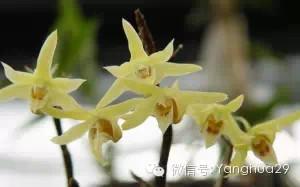
Growth habit
Dendrobium candidum is suitable to grow in a cool, moist and smooth air environment.
Born on semi-shady and humid rocks in mountains up to 1600 meters above sea level, like warm and humid climate and semi-overcast and semi-Yang environment, not cold-resistant.
Culture method
1. For the seed material of potted Dendrobium, 1/3 pebbles with a particle size of 2-3 cm were used at the bottom of the pot, and 2/3 fine crushed bark and crushed stones were used in the upper part.
2. The best season for transplanting Dendrobium into pots is from the Spring Equinox to Qingming Festival, which is the sprouting season, and new buds will grow immediately after planting. Pay attention to the depth, too deep to bury the germination point under the plant material, will affect the germination rate, too shallow root is difficult to moisturize, affect growth, we should pay attention to the season and cultivation techniques
3. Maintenance and management: different environments and methods of domestic Dendrobium. Planted on the balcony or window frame where Rain Water cannot be drenched directly, during this period of spring, because Dendrobium herbs love the sun, it is suitable for direct sunshine; open-air balcony planting should pay attention to heavy rain or too much rainfall, easy to rot roots and seedlings, the upper shed cover for prevention. According to the actual situation, watering is generally 5-7 days, but not too wet or too dry.
4, summer and autumn season: the balcony or window frame without Rain Water is sprayed at 6 am every day, and the open-air balcony is covered with a shade shed to prevent Rain Water or strong sunlight.
5. Spray water once every 7-10 days on the balcony or window frame in winter, suitable for direct sunlight, do not spray water below 5 ℃, fertilize, smash longan shell and litchi shell and put them on the basin surface. Watch out for snails.
Harvest: sprout harvest at the end of spring every year, cut off more than three-year-old stems and branches, leaving buds, so that they can continue to grow.
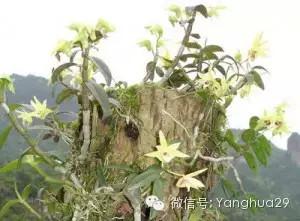
Reproduction method
Tissue rapid propagation
The tissue culture seedlings should be refined for 14 to 21 days before cultivation. The specific measures are to move the tissue culture seedlings to the seedling training room so that they can gradually adapt to the natural environment in the open and changing environment. When the leaves of the tissue culture seedlings are dark green, they can be planted in bottles.
Open the bottle cap before coming out of the bottle and let the bottle seedlings be placed in the outdoor air for 2-3 days to adapt to the natural temperature and humidity. Then wash the seedlings, gently take out the seedlings with culture medium and wash them in the basin. The contaminated seedlings and bare-root seedlings or few-root seedlings should be placed separately. Tissue culture seedlings are first washed with tap water, mainly to wash off Agar to avoid Agar mildew causing rotting roots, and then rinse with clean water. When washing seedlings, it is best to grade them synchronously according to their size, advantages and disadvantages, so as to cultivate, manage, improve the survival rate of tissue culture seedlings and make them grow neatly.
Ramet cuttage propagation
One-year-old or two-year-old plants with bright green color, strong germination, developed root system and no diseases and insect pests were selected as seed plants. The withered branches, broken branches, old branches and overlong fibrous roots were cut off, and the clumps were divided into small clumps. 5-7 stems with leaves in each cluster can be planted.
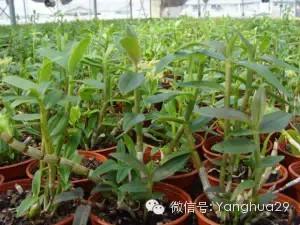
Cultivation techniques
Transplanting time
The cultivation time of Dendrobium candidum is generally spring and autumn every year, and spring is better than autumn. In Zhejiang, the best time for cultivation of Dendrobium candidum is from mid-April to late June, when the air temperature is 12: 25 ℃, and the air humidity is high, the survival rate of test-tube plantlets is higher and the growth time is longer, and the second is from mid-September to late October.
Cultivation substrate
The cultivation substrate is the key to high quality and efficient cultivation. The biological characteristics of Dendrobium candidum require that the cultivation substrate has both good water retention and ventilation, and large-scale production requires that the raw materials of the cultivation substrate are easy to obtain and easy to operate. The reported substrates include water moss, gravel, peanut shell, moss, coconut bark, pine bark, sawdust, charcoal and wood blocks, which are mainly used in the production of bark, sawdust, or a mixture of bark, sawdust, gravel and organic fertilizer, in which the bark is crushed into particles below 2~3cm.
Cultivation conditions
The cultivation of Dendrobium candidum should be carried out in the greenhouse, and the construction of the greenhouse should be ventilated, shaded and protected from rain, with insect-proof net, and according to the growth habits of Dendrobium candidum, the natural factors such as light, temperature, humidity and ventilation should be considered. The suitable temperature for the growth of Dendrobium candidum is 15: 30 ℃, which is relatively hot in summer in Zhejiang. It is generally covered with 80% sunshade net to lift the plastic film to facilitate cooling; it is relatively cold in winter and sealed with double-layer plastic film under 30% to 50% sunshade. Dendrobium candidum is required to keep the substrate moist, it is better to keep the air humidity above 80%, but not stagnant water. Sprinkler irrigation or drip irrigation is the best method for watering, and no flushing irrigation is allowed. The amount of water is also different in different regions in different seasons.
Attached cultivation
Dendrobium candidum is an epiphytic plant, which mainly grows on the shady trunk or limestone of some tall trees under natural conditions, so it can also be planted under artificial breeding and cultivation conditions. According to the characteristics of the host, the artificial main planting of Dendrobium candidum can be divided into three forms: tree planting, stone planting and humus soil cultivation.
When planting, broad-leaved tree species with thick bark, high water content, dense crown, herbaceous or waxy leaves and longitudinal furrow bark (such as Phellodendron chinense, pear tree, camphor tree, etc.) can be selected as cultivation appendages, while stone planting chooses rough texture, pine bubbles easy to absorb moisture, and stones with humus soil or moss attached to the surface as planting appendages. When humus soil is cultivated, a tall box with high 15cm is made of brick or stone under a more humid forest, and the humus soil, fine sand and gravel are well mixed and filled into the compartment. After leveling, it can be planted, and a shade with high 100~120cm is built on the side of the box.
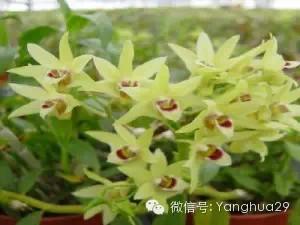
Disease prevention and cure
Dendrobium soft rot
It is easy to occur in the environment of high temperature and humidity, and the disease is fast, and when it is serious, the whole plant decays and disintegrates in the form of wet rot.
Prevention and treatment: at the initial stage of the disease, the control effect of 2000 mg/ kg was the best with 77% Kesha 101 wettable powder, and the control effect reached more than 78% 12 days after spraying. You can also use 80% methyl topiramate wettable powder 800 times liquid spray. At the same time, it is necessary to strengthen the management in the shed, pay attention to ventilation and light transmission and reduce the humidity in the shed. If you get sick, you should remove the diseased plant in time, and use broad-spectrum antimicrobial agents, such as topzine, carbendazim, Cobo, etc., and then re-use the disinfected substrate to plant.
Black spot of Dendrobium
Damage to the leaves, so that the leaves withered, usually occurred in March to May.
Prevention and treatment: 50% carbendazim 1000 times solution can be sprayed 2 times for 3 times.
Dendrobium anthracnose
Damage to leaves and fleshy stems, the damaged leaves showed brown or black disease spots, which generally occurred from January to May.
Prevention and treatment: 50% carbendazim 1000 times solution or 50% methyl topiramate 1000 times solution can be sprayed 2 times for 3 times.
Snail
Common pests damage young stems, young leaves, buds and young fruits.
Prevention and control methods: it can be controlled by artificial trapping, poison bait or sprinkling lime and tea bran.
Dendrobium phenanthrene shield scale
Parasitic on the edge of plant leaves or on the back of the plant to suck sap, late May is the peak period of hatching.
Control methods: 1000 times of 40% dimethoate EC or 1000 times of 50% malathion can be used to spray and kill insects, or burn the old branches concentrated with Phyllostachys sinensis.
Red spider
Prevention and control methods: it can be controlled by removing weeds in the surrounding environment or spraying 800 and 1000 times low-toxic acaricides, such as 40% dicofol.
-
Knowledge of flower cultivation
Wechat: yanghua29
Flower cultivation knowledge, ask and answer, solve the problem of flower cultivation!
- Prev
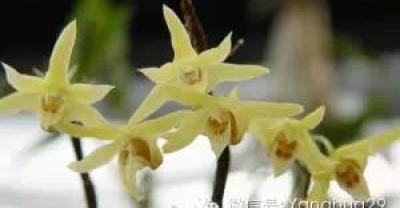
There is a way to cultivate fish scientifically, and water is raised first.
In the process of aquaculture, various aquaculture problems are often encountered, among which there are such problems. Just like: pigs, chickens, etc., in the farm.
- Next
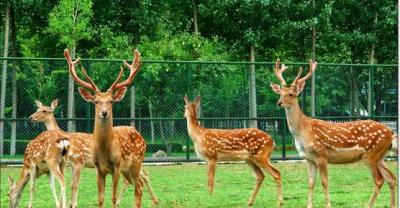
Program Management of Drug use in White Feather Broiler breeding (Collection Edition)
If you are also a friend of chicken farmers, if you want to consult about chicken disease, you can click on the link below to get my contact information: how to raise chickens in winter.
Related
- On the eggshell is a badge full of pride. British Poultry Egg Market and Consumer observation
- British study: 72% of Britons are willing to buy native eggs raised by insects
- Guidelines for friendly egg production revised the increase of space in chicken sheds can not be forced to change feathers and lay eggs.
- Risk of delay in customs clearance Australia suspends lobster exports to China
- Pig semen-the Vector of virus Transmission (4)
- Pig semen-the Vector of virus Transmission (3)
- Five common causes of difficult control of classical swine fever in clinic and their countermeasures
- Foot-and-mouth disease is the most effective way to prevent it!
- PED is the number one killer of piglets and has to be guarded against in autumn and winter.
- What is "yellow fat pig"? Have you ever heard the pig collector talk about "yellow fat pig"?

